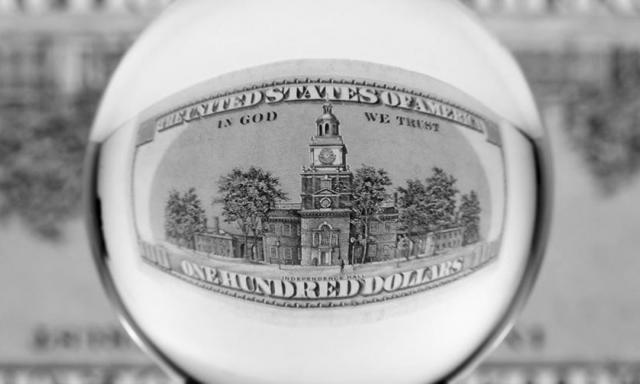

 Article
Article

 Delivering his annual economic forecast, Darden Professor Alan Beckenstein predicted continued modest improvement in key economic indicators such as GDP and the unemployment rate, but suggested a new recession could be looming.
Delivering his annual economic forecast, Darden Professor Alan Beckenstein predicted continued modest improvement in key economic indicators such as GDP and the unemployment rate, but suggested a new recession could be looming.

Insights from
Written by
As the United States continues to navigate through poorly charted economic waters, additional turmoil may be on the horizon.
Delivering his annual economic forecast to an assembled crowd at the University of Virginia Darden School of Business, Darden Professor Alan Beckenstein predicted continued modest improvement in key economic indicators such as GDP and the unemployment rate, but suggested a new recession could be looming, as well.
Beckenstein painted a picture of an unusual time in U.S. economic history. It’s a time during which the U.S. remains something of an economic anomaly amid the global tumult, but the true, underlying health of the U.S. economy remains the subject of controversy, as a years-long expansionary monetary policy and true labor force participation rates may skew the traditional metrics.
“The financial markets are distorted by seven to eight years of artificially low interest rates,” Beckenstein said, calling it a “bad sign” when the Federal Reserve’s action — or inaction — on interest rates becomes a primary market mover.
And while the Fed did end 2015 with a modest interest rate hike, some observers believe further increases appear less likely if the economy shows signs of wobbliness. Beckenstein suggested that one benefit of raising interest rates is the policy space it instantly creates, as the Fed could later decrease interest rates in the face of a negative economic event.
Before making his 2016 forecast, Beckenstein reviewed his previous forecast versus actual results for 2015, in which his projected 3.2 percent GDP growth proved too high for the actual 2.15, his core inflation of 1.8 percent proved a bit lower than the actual 2.02 percent and his projection of the average unemployment rate of 5.3 percent lined up perfectly with the actual.
The volatility of the Dow Jones Industrial Average proved slightly greater than Beckenstein projected, with the 2,981 point swing higher than his forecast of 2,300.
Although 2015 saw many economic positives, including generally healthy corporate earnings, consumption growth, a rise in home values and a decline in household debt, Europe remained a drag on the world economy and business investment remained tepid.
Quoting Christine Lagarde, the managing director of the International Monetary Fund, Beckenstein said the U.S. may simply be in the “new mediocre.”
Looking ahead to the rest of the year, Beckenstein forecast additional sluggish growth coupled with even more volatility.
His economist forecast included 2.6 percent GDP growth for an adjusted 2016 — representing the fourth quarter of 2015 to the third quarter of 2016 — with core inflation of 1.8 percent and an average unemployment rate of 4.8 percent. The spread between the high and the low on the Dow Jones Industrial Average for the year will be at least 3,000 points, he said. His forecast would be lower for GDP growth if the recession began earlier than the fourth quarter of 2016.
Beckenstein put the probability of a negative growth quarter by the middle of 2017 at 50 percent, with the precise quarter depending on the exact timing of a recession that he expects to hit as early as the fourth quarter of 2016.
“The key is, what is the timing of the recession that’s coming?” Beckenstein said. “It’ll come. We’re due.”
Noting the roughly seven years since the last recession ended, Beckenstein said it had been an unusually long period without a major shock to the system. The economist said there were many candidates for a global shock to the world’s economy, with potential negative events including the continuation of a more restrictive federal monetary policy resulting in a “wealth shock,” or some other major event in the global economy.
Indeed, if interest rates continue to rise, and we see a resultant drop in bond prices on the secondary market, the subsequent wealth shock could lead to contagion in the equity and housing markets, which could be one path to recession.
Despite the mixed outlook, Beckenstein said the longer term outlook for the U.S. remained reasonably strong, noting the diversified economy and a sophisticated labor force.
It may just be a bumpy ride to the longer term.
Beckenstein is an authority on the impact of public policy and global events on companies and industries. He has worked in the areas of competition policy — antitrust, regulation and deregulation — as it affects company decision-making, as well as similar issues in environmental policy, and global economic and financial shocks. Beckenstein has been engaged in teaching and research on both the U.S. economy and other regions globally. He has worked extensively in Asia-Pacific economies and has served as a consultant to government agencies and international corporations.
Beckenstein has been engaged in research and teaching in New Zealand for two decades. He has led a two-week executive development course there and has written numerous case studies on business and government organizations in New Zealand.
A 30-year veteran of Darden’s senior executive program (TEP), Beckenstein has taught executives globally for four decades.
A.B., Lafayette College; M.A., Ph.D., University of Michigan
Professor Beckenstein teaches in the Executive Education program The Executive Program: Strategic Leadership at the Top.
2016 Economic Forecast: ‘We’re Due’ — Recession May Loom for US Economy
Share